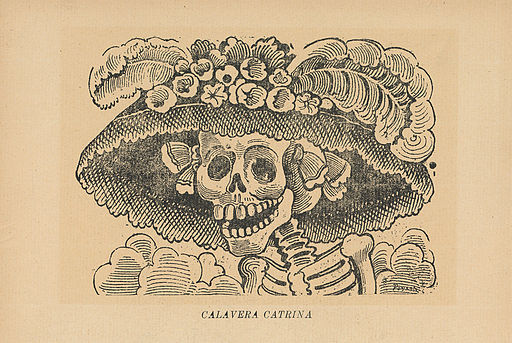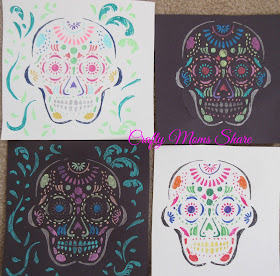I have 2 current giveaways!! One for an Origami Toy Monsters Book & Kit and the other for 2 DVDs.
Not being Mexican or even Hispanic and not being Catholic, I did not know much about the Day of the Dead. In fact I found the skeletons a bit creepy. The past few years I have explored the holiday with Hazel and realized what a touching holiday it really is and now I like the skeletons and especially the skulls. This year we took two new books out of the library to explore the holiday a bit more.
Dia De Los Muertos by Roseanne Greenfield Thong tells the story of the Day of the Dead in a village. The book includes some Spanish vocabulary to help explain the various events. The book makes the reader realize this is a festive occasion and not a scary one. It even goes as far to talk about how no one is afraid even with the bones (costumes and skull masks people wear). It really helps get the message about how it is a holiday to honor the dead.
Funny Bones: Posada and His Day of the Dead Calaveras by Duncan Tonatiuh tells the story of Jose Guadalupe Posada. Posada is well known for his calavera drawings.Some of his drawings were fun and a few were serious and others poked fun of politicians and others. Above is a famous one. It was really intersting to learn about Posada and his life.
To make some crafts for the Day of the Dead we started with a store bought stencil. (I got it at the Paper Source since I work there now.) We had fun making some pictures with it and our gel pens.
As I was using the stencil I thought about the symmetry of sugar skulls. Of course the designs outside the skull on the stencil were not symmetric, so I left them off of two of the pictures. Always the math teacher in me I guess. I would ask students to find the line of symmetry and ask about rotational symmetry. Perhaps take one part (an ear, eye, mouth, etc.) and look for the types of symmetry. I could keep going, but need to get back to the post about the holiday.
We also bought a sugar skull rubber stamp at the Paper Source. Hazel loves using rubber stamps and embossing powder. She learned it over the summer in a craft class and every once in awhile I let her pull out the materials that I already had so she can play. We did it with the sugar skulls so we could color them in. I colored some in and left the rest for Hazel who has not gotten around to it yet. I colored them with gel pens and markers. For those that do not know about embossing, you sprinkle a special powder onto the image while the ink is wet and then use a heating tool to melt the powder and seal it to the paper. It makes the image raised, shiny and sometimes sparkly depending on the type of embossing powder. The powder comes in various colors as well as glitter added and more. The ink will not show through if a colored powder is used and if you want the ink to show you use a clear powder. (At some point I will demonstrate it in a post.) I left some uncolored on these sheets to see the differences.
While we were checking out all the Day of the Dead supplies at the store, Hazel asked why they are called sugar skulls and where the idea came from. Well I did a little research. Sugar art was brought to Mexico by Italian missionaries. Since there was great sugar production in Mexico and little money to buy the expensive European decorations so they learned to make their own from the friars. This occurred in the 17th century. In colonial times sugar decorations were common place in Mexico for various holidays. Sugar skulls were used to represent a departed soul and would have the name on it. (Source) If you want to attempt your own, I found this recipe and tutorial.
Our last craft was a simple DIY stained glass kit that we picked up for $1 at the Christmas Tree Shop. Hazel painted it after embossing all the skulls from the rubber stamp.
Something I found interesting while doing a bit of research. The indigenous people of Mexico believe that the souls of the dead children return at midnight on the 31st and reunite with their families for 24 hours and the adult souls come on November 2nd to enjoy the festivities prepared for them. Many of the indigenous families spend two months salary to honor their dead family. It is an expensive holiday for them. (Source)
This post is part of the Multicultural Kid Blogs' Day of the Dead Series. Be sure to check out the other posts in the series and if you have a post on the Day of the Dead there is a link party there to share it as well!
Not being Mexican or even Hispanic and not being Catholic, I did not know much about the Day of the Dead. In fact I found the skeletons a bit creepy. The past few years I have explored the holiday with Hazel and realized what a touching holiday it really is and now I like the skeletons and especially the skulls. This year we took two new books out of the library to explore the holiday a bit more.
Dia De Los Muertos by Roseanne Greenfield Thong tells the story of the Day of the Dead in a village. The book includes some Spanish vocabulary to help explain the various events. The book makes the reader realize this is a festive occasion and not a scary one. It even goes as far to talk about how no one is afraid even with the bones (costumes and skull masks people wear). It really helps get the message about how it is a holiday to honor the dead.
 |
| Calavera Catrina by José Guadalupe Posada [Public domain], via Wikimedia Commons |
To make some crafts for the Day of the Dead we started with a store bought stencil. (I got it at the Paper Source since I work there now.) We had fun making some pictures with it and our gel pens.
As I was using the stencil I thought about the symmetry of sugar skulls. Of course the designs outside the skull on the stencil were not symmetric, so I left them off of two of the pictures. Always the math teacher in me I guess. I would ask students to find the line of symmetry and ask about rotational symmetry. Perhaps take one part (an ear, eye, mouth, etc.) and look for the types of symmetry. I could keep going, but need to get back to the post about the holiday.
We also bought a sugar skull rubber stamp at the Paper Source. Hazel loves using rubber stamps and embossing powder. She learned it over the summer in a craft class and every once in awhile I let her pull out the materials that I already had so she can play. We did it with the sugar skulls so we could color them in. I colored some in and left the rest for Hazel who has not gotten around to it yet. I colored them with gel pens and markers. For those that do not know about embossing, you sprinkle a special powder onto the image while the ink is wet and then use a heating tool to melt the powder and seal it to the paper. It makes the image raised, shiny and sometimes sparkly depending on the type of embossing powder. The powder comes in various colors as well as glitter added and more. The ink will not show through if a colored powder is used and if you want the ink to show you use a clear powder. (At some point I will demonstrate it in a post.) I left some uncolored on these sheets to see the differences.
While we were checking out all the Day of the Dead supplies at the store, Hazel asked why they are called sugar skulls and where the idea came from. Well I did a little research. Sugar art was brought to Mexico by Italian missionaries. Since there was great sugar production in Mexico and little money to buy the expensive European decorations so they learned to make their own from the friars. This occurred in the 17th century. In colonial times sugar decorations were common place in Mexico for various holidays. Sugar skulls were used to represent a departed soul and would have the name on it. (Source) If you want to attempt your own, I found this recipe and tutorial.
Our last craft was a simple DIY stained glass kit that we picked up for $1 at the Christmas Tree Shop. Hazel painted it after embossing all the skulls from the rubber stamp.
 |
| Ofrenda en biblioteca de Mixquic (Offering in Library) By Guillerminargp (Own work) [CC BY-SA 3.0], via Wikimedia Commons |
Something I found interesting while doing a bit of research. The indigenous people of Mexico believe that the souls of the dead children return at midnight on the 31st and reunite with their families for 24 hours and the adult souls come on November 2nd to enjoy the festivities prepared for them. Many of the indigenous families spend two months salary to honor their dead family. It is an expensive holiday for them. (Source)
This post is part of the Multicultural Kid Blogs' Day of the Dead Series. Be sure to check out the other posts in the series and if you have a post on the Day of the Dead there is a link party there to share it as well!










No comments:
Post a Comment
I love to hear your comments and ideas. Thank you for reading and contributing!